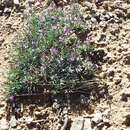Comprehensive Description
provided by North American Flora
Homalobus brachycarpus Nutt.; T. & G. Fl. N. Am
1: 352. 1838.
Astragalus simplklfoliiisS. Wats. Bot. King's Expl. 77. 1871. Not A. simplicifolius A. Gray. 1864. An acaulescent perennial, with a densely tufted cespitose caudex, unifoliolate or rarely 3-foliolate, 1-3 em. long, silky-canescent; stipules scarious, ovate, pubescent; blades or leaflets oblanceolate or spatulate, 2-3 mm. broad, acute or the earlier ones obtuse; peduncles 2-5 cm. long, 3-7-flowered; bracts lanceolate or ovate, scarious, shorter than the calyx; calyx silkycanescent, the tube 2 mm. long, the teeth subulate, about as long; corolla bluish-purple, similar to that of H. caespitosus, but smaller, 6-8 mm. long; pod oblong, abruptly acute, 6-8 mm. long, 3 mm. wide, strigose; seed 2-2.5 mm. long, scarcely 1.5 mm. wide.
Type locality: Hills of the Platte, towards the Rocky Mountains [Wyoming). Distribution: Wyoming, northern Colorado, and northeastern Utah.
- bibliographic citation
- Per Axel Rydberg. 1919. (ROSALES); FABACEAE; PSORALEAE. North American flora. vol 24(1). New York Botanical Garden, New York, NY
Comprehensive Description
provided by North American Flora
Homalobus uniflorus Rydb. Bull. Torrey Club 34: 49. 1917
An acaulescent perennial, with a cespitose tufted caudex; leaves unifoliolate, tufted at the end of its branches, 1-3 cm. long, 1-3 mm. wide, silky-canescent; stipules scarious, ovate or lanceolate, pubescent, free ; leaf-blades oblanceolate, acute, tapering below into narrow petioles ; bracts filiform-subulate, usually as long as or longer than the flowers; calyx canescent, the tube campanulate, 2 mm. long, the teeth subulate, about the same length; corolla dark bluishpurple ; banner 8 mm. long ; wings about the same length, the blade obliquely oblong-lanceolate, rounded at the apex, with an acute basal auricle, the claw half as long as the blade; keel-petals shorter, the blade broadly lunate, almost semicircular, rounded at the apex and with a rounded basal auricle; pod lanceolate, 5-8 mm. long, 2.5-3 mm. wide, tapering at each end, strigose; seeds obliquely oblong, 2 mm. long, 1 mm. wide.
Type locality: Evanston, Wyoming. Distribution: Uintah County, Wyoming.
- bibliographic citation
- Per Axel Rydberg. 1919. (ROSALES); FABACEAE; PSORALEAE. North American flora. vol 24(1). New York Botanical Garden, New York, NY
Comprehensive Description
provided by North American Flora
Homalobus caespitosus Nutt.; T. & G. Fl. N. Am
1:352. 1838.
Homalobus canescens Nutt.; T. & G. Fl. N. Am. 1: 352. 1838. Not A. canescens DC. 1802.
Astragalus caespitosus A. Gray, Proc. Am. Acad. 6: 230. 1864. Not A. caespitosus Pallas. 1800.
Tragacanlha caespilosa Kuntze, Rev. Gen. 943. 1891.
Astragalus spalulatus Sheldon. Minn. Bot. Stud. 1: 22. 1894.
Astragalus simplicifolius caespitosus M. E. Jones, Proc. Calif. Acad. II. 5: 647. 1895.
Astragalus simplicifolius spalulatus M. E. Jones, Contr. W. Bot. 10: 65. 1902.
An acaulescent perennial, with a cespitose, densely tufted caudex; leaves clustered on the ends of the caudex, unifoliolate or rarely 3-5-foliolate, silky-canescent, 2-4 cm. long; stipules scarious, pubescent, lanceolate or ovate; leaf-blades or leaflets linear-oblanceolate, acute, 1-3 mm. w-ide; peduncles 2-6 cm. long, 3-7-flowered; bracts subulate or lanceolate, scarcely half as long as the flowers; calyx silky-canescent, the tube campanulate, 2 mm. long, the teeth subulate, nearly as long; corolla bluish-purple; banner 8-9 mm. long, obovate, with a broad daw, reflexed, retuse at the apex; wings about as long, the blade obliquely oblanceolate, rounded at the apex, with an acute basal auricle, the claw two thirds as long; keel-petals much shorter than the wings, the blade nearly semicircular, rounded at the apex, the claw nearly as long; pod oblong, gradually acute, 8-12 mm. long, 2.5-3 mm. broad, strigose, sessile; seeds obliquely oblong, 2 mm. long, nearly 1.5 mm. broad, with the funicle near the broader end.
Type locality: Dry hills of the Platte towards the Rocky Mountains [Nebraska or Wyomingj.
Distribution: Hills and bad-lands, Saskatchewan and North Dakota to northeastern Utah and northern Colorado.
- bibliographic citation
- Per Axel Rydberg. 1919. (ROSALES); FABACEAE; PSORALEAE. North American flora. vol 24(1). New York Botanical Garden, New York, NY
Physical Description
provided by USDA PLANTS text
Perennial, Herbs, Stems woody below, or from woody crown or caudex, Taproot present, Nodules present, Stems very short, acaulescent or subacaulescent, Stems prostrate, trailing, or mat forming, Stems less than 1 m tall, Stems solid, Stems or young twigs sparsely to densely hairy, Stems with 2-branched hairs, dolabriform, Leaves alternate, Leav es petiolate, Stipules conspicuous, Stipules membranous or chartaceous, Stipules persistent, Stipules connate to each other, forming a tuber or sheath, Leaves simple, or appearing so, Leaves compound, Leaf or leaflet margins entire, Leaflets opposite, Leaflets 1, Leaflets 2, Leaflets 4, Leaflets 5-9, Leaves hairy on one or both surfaces, Inflorescences racemes, Inflorescence axillary, Bracts very small, absent or caducous, Flowers zygomorphic, Calyx 5-lobed, Calyx hairy, Petals separate, Corolla papilionaceous, Petals clawed, Petals pinkish to rose, Petals blue, lavander to purple, or violet, Banner petal narrow or oblanceolate, Wing petals narrow, oblanceolate to oblong, Wing tips obtuse or rounded, Keel petals auriculate, spurred, or gibbous, Keel tips obtuse or rounded, not beaked, Stamens 9-10, Stamens diadelphous, 9 united, 1 free, Filaments glabrous, Style terete, Style persistent in fruit, Fruit a legume, Fruit unilocular, Fruit humistrate, lying on the ground, Fruit freely dehiscent, Fruit oblong or ellipsoidal, Fruit coriaceous or becoming woody, Fruit exserted from calyx, Fruit beaked, Fruit glabrous or glabrate, Fruit hairy, Fruit 3-10 seeded, Seeds cordiform, mit-shaped, notched at one end, Seed surface smooth, Seeds olive, brown, or black.

